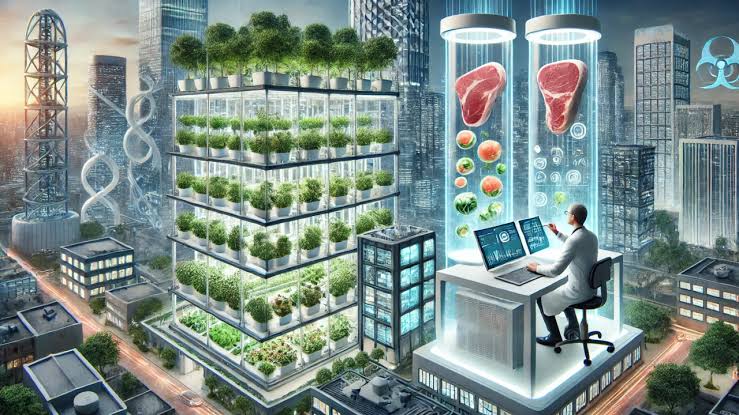As the world’s population grows, cities get bigger, and climate change gets worse, feeding billions of people sustainably is a big challenge. Traditional farming is important but can’t keep up without using up resources or hurting the environment. As of July 2025, two new technologies—vertical farming and lab-grown meat—are changing how we produce food. They offer a future where food is more sustainable, efficient, and better for the planet.
These innovations not only challenge the norms of agriculture and livestock farming but also hold the potential to significantly reduce greenhouse gas emissions, cut down on water usage, and bring fresh produce and protein closer to consumers in urban settings. As the world adapts to technological change and ecological constraints, vertical farming and cultivated meat are no longer niche ideas—they are gaining traction as viable, scalable solutions.
What is Vertical Farming?
Vertical farming is the practice of growing crops in vertically stacked layers, often in controlled indoor environments using hydroponics, aeroponics, or aquaponics. These farms are typically set up in urban warehouses, shipping containers, or specially designed vertical structures, where artificial lighting, climate controls, and nutrient solutions replace traditional sunlight, soil, and weather patterns.
One of the key benefits of vertical farming is space efficiency. In cities where arable land is scarce and expensive, growing upward rather than outward allows for significantly higher yields per square foot. As of 2025, major cities like Singapore, Tokyo, New York, and London have seen a rise in commercial vertical farms that produce herbs, leafy greens, strawberries, and even staple crops like rice.
Vertical farms are also largely immune to weather disruptions and pests, which reduces the need for pesticides and mitigates the risks posed by droughts, floods, and extreme temperatures. Moreover, they use up to 90% less water than conventional farming, making them ideal for water-scarce regions.
The Rise of Lab-Grown Meat
Lab-grown meat, also known as cultured meat or cultivated meat, is produced by cultivating animal cells in a controlled environment without raising or slaughtering live animals. The process involves taking a small sample of animal tissue, usually muscle cells, and feeding those cells a nutrient-rich solution that enables them to grow into muscle tissue similar to what we consume as meat.
As of July 2025, lab-grown meat is moving closer to mainstream availability. Companies like Mosa Meat, GOOD Meat, and Aleph Farms have received regulatory approvals in parts of the United States, the EU, and Asia, allowing for the limited sale of cultured beef, chicken, and seafood. Production costs have steadily declined, though lab-grown meat still remains more expensive than traditional meat in most markets. However, with advancements in bioreactor technology and supply chains, prices are expected to fall significantly in the coming years.
The potential benefits of lab-grown meat are enormous. It drastically reduces the environmental footprint of meat production—cutting down on methane emissions, land use, and water consumption—while addressing ethical concerns related to animal welfare. For consumers concerned about antibiotic use and foodborne illnesses, cultured meat also offers a cleaner alternative.
Environmental and Ethical Advantages
One of the strongest arguments in favor of both vertical farming and lab-grown meat is their positive impact on the environment. Traditional agriculture is responsible for about 70% of global freshwater usage and nearly 25% of greenhouse gas emissions, much of which comes from livestock. Deforestation, soil erosion, and chemical runoff further exacerbate the environmental toll.
Vertical farming eliminates the need for arable land, thereby reducing deforestation. It also cuts down on transportation emissions, as food can be grown and consumed locally in urban centers. Cultured meat, if adopted widely, could reduce livestock farming, which contributes heavily to methane emissions and resource-intensive feed production.
Ethically, lab-grown meat addresses the concerns of millions of consumers who are reducing or eliminating meat consumption due to the cruelty of factory farming. It provides an option for those who want to enjoy the taste and texture of meat without supporting inhumane practices.
Challenges and Criticisms
Despite their promise, both vertical farming and lab-grown meat face significant hurdles. The energy demands of indoor farming are high, especially when using artificial lighting for plant growth. While renewable energy integration is improving, critics argue that the carbon footprint of vertical farms needs further reduction before they can be called truly sustainable.
Lab-grown meat, on the other hand, faces challenges in consumer acceptance. Many people remain skeptical or even uncomfortable with the idea of eating meat produced in a lab. Additionally, scaling up production to meet global demand while maintaining consistent taste, texture, and nutrition remains a technical challenge.
There are also economic considerations. While prices are dropping, lab-grown meat is still not affordable for the average consumer. Vertical farming is more financially viable for high-margin crops like herbs and salad greens, but less so for staple crops such as wheat or corn, which require larger-scale outdoor agriculture for cost efficiency.
The Role of Policy and Investment
Governments and private investors play a critical role in accelerating the adoption of these technologies. As of 2025, many countries are investing in agricultural innovation grants, subsidies, and startup funding to encourage development in this sector. In the European Union and parts of Asia, research institutions are partnering with biotech firms to refine production methods and scale up pilot projects.
Policies promoting sustainable food systems and environmental conservation are also helping pave the way for vertical farming and lab-grown meat. In some cases, cities are rewriting zoning laws to allow for urban agriculture and creating tax incentives for companies that develop sustainable food technologies.
Consumer education is another essential aspect. Helping the public understand the benefits, safety, and environmental necessity of these innovations will go a long way in driving market demand and acceptance.
Future Outlook
Looking ahead, the integration of artificial intelligence, automation, and biotechnology will further enhance the efficiency and scalability of vertical farming and cultured meat. Smart sensors, predictive analytics, and robotics will streamline operations, while gene-editing technologies may be used to enhance nutritional content or growth speed.
Hybrid models, such as combining vertical farming with aquaculture or producing blended meat products (half plant-based, half lab-grown), are emerging to balance cost and consumer preferences. These innovations could offer a more gradual transition for consumers hesitant to adopt fully lab-grown products.
In a world facing rising food insecurity, worsening climate change, and limited agricultural land, vertical farming and lab-grown meat represent a forward-thinking solution. Though challenges remain, the progress made by mid-2025 suggests that these innovations are not just theoretical possibilities—they are part of the future of food production.



